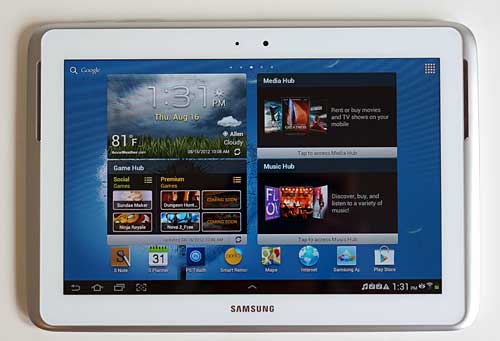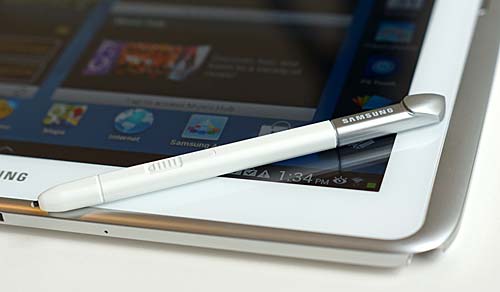The Samsung Galaxy Note 10.1 is finally here, 6 months after its announcement at Mobile World Congress in Barcelona. And who'd guess that a stalwart Samsung product could be so polarizing? Some reviewers like it while others dismiss it. Spoiler: we really like it. It's no secret that I'm the "pen lady", the person who understands and appreciates the use of an active digitizer and pen (be it Wacom or N-Trig) for drawing and note taking. I love to draw and paint; it's in my blood: my mother is a painter. But for those of you who aren't so artistically inclined and love to take good old fashioned meeting notes by hand rather than on-screen keyboard and like to annotate PDFs and Office documents, the Galaxy Note 10.1 has a decided appeal. For those who aren't sure if the pen is a gimmick or a blessing, there's enough to move the Note 10.1 to the top of the tablet heap: the Samsung is one of the fastest Android tablets on the market, its quality is up to Samsung's usual high standards and there are plenty of other features like the AV remote, pop-up video player and easy content sharing with the Samsung Galaxy S III smartphone.

Other Pen Tablet Competitors
Only a handful of tablets come with active digitizers and digital pens that offer pressure sensitivity and more precise input than capacitive styli for Android and the iPad. These include the Lenovo ThinkPad Tablet, the HTC Flyer and Jetstream running Android along with Windows 7 tablets that cost twice as much and have weaker touch optimization. The Samsung Galaxy Note 10.1 brings the pen to a relatively affordable $499 tablet that Samsung hopes will be as successful as the Samsung Galaxy Notesmartphone that's sold 10 million units to date.
Specs
The tablet has a lot going for it beyond the S pen: a very fast quad core 1.4GHz Exynos CPU, 2 gigs of RAM and 16 or 32 gigs of storage. It has dual band WiFi 802.11b/g/n, Bluetooth 4.0 and a GPS with Glonass along with a front 1.9MP camera and rear 5MP camera with LED flash. It's slim at 0.35" and light at 1.3 pounds. Like other recent Samsung tablets, the Note 10.1 has an IR blaster and the Peel AV remote and TV programming guide so you can control your home theater gear.
The tablet runs Android OS 4.0.4 Ice Cream Sandwich with Samsung's TouchWiz UI and enhancements and it has several custom apps including the attractive S Planner calendar, a capable music player and a side-by-side app option for key apps like the web browser, video player, Polaris Office (an MS Office compatible suite) and Samsung's S Note application so you can work in these apps simultaneously as you would with a desktop OS like Windows 7 or Mac OS X.
Design and Ergonomics
The Galaxy Note 10.1 sports the same revised design as the Galaxy Tab 2 10.1 (terrible name), and that means it's not a dead ringer for the iPad and has design improvements like front-facing stereo speakers that are fairly loud and full. Available in white or deep gray plastic, it's not the paragon of high class materials, but the white model has a clean and appealing look while the gray version has a faux brushed metal back.

The standard Samsung dock connector is on the bottom, and it's compatible with Samsung's existing line of tablet accessories like the USB adapter, HDMI adapter and chargers. All controls are on the top edge (when held in landscape mode). These include power, a volume rocker, microSD card slot under a plastic door, the IR window and 3.5mm audio jack. The active pen silo is on the bottom right corner. When you remove the pen from its silo, an app launcher of pen-centric apps pops up on the display's right side. You can customize this to do nothing instead, or launch your preferred pen app (S Note, Adobe Photoshop Touch and more). Nice. You can also tell the tablet to save a little power and disable the active digitizer unless the pen is removed from the silo.

As ifixit.com has shown, the Samsung Galaxy Note 10.1 is a thing of beauty inside: nearly every major component is replaceable, including the glass over the LCD. Most tablets have components soldered to the motherboard and the top glass is often fused to the LCD and digitizer, making repairs more expensive and difficult. We applaud Samsung's clean and repairable design that some other manufacturers avoid because it increases costs. We also appreciate the name brand components inside, including Samsung flash memory (Samsung makes very fast flash storage), a Wolfson Audio controller and a name brand dual band WiFi chip.
Display
The Gorilla Glass-clad PLS display is bright and has plenty of color saturation, as you'd expect from Samsung. Is it a wild leap forward from the very good Samsung Galaxy Tab 10.1? Not so much, but at 1280 x 800 resolution with rich colors and plenty of contrast, it doesn't send us running back to our 1920 x 1200 Asus Transformer Pad infinity TF700. If you look closely, you'll notice the fonts on the Samsung aren't as finely wrought compared to the Asus, and images lack that exquisite level of 1080+ detail, but it's still very nice. Given the work Samsung had to do in order to make a tablet with a Wacom digitizer under Android and the fact that Wacom and N-Trig digitizers haven't yet been paired with super-high resolution displays, we're not surprised at the tablet's standard resolution. And the standard resolution helps keep the price affordable. If you find the S pen useful, it will likely be worth the trade off.
The display is better than the budget oriented Samsung Galaxy Tab 2 10.1display, and it's a tad sharper and less cartoony colorful than the original Tab 10.1. The tablet has three color saturation settings and the default setting is pleasing in terms of color saturation. The display is quite bright, as Samsung's PLS (their answer to IPS) displays usually are, though it can't compete with the insanely bright Asus Transformer Prime andInfinity Super IPS Plus displays, which are the brightest tablet displays on the market. The Asus super bright option is serious overkill for indoor use, but it shines when outdoors in sunlight. That said, today's glossy tablets are hard to see outdoors in direct sunlight because they fade a bit and because glare obscures what's on screen. We could make out what was on screen when outdoors under sunshine with the Samsung, but it's not something you'd want to do for extended periods of time.
